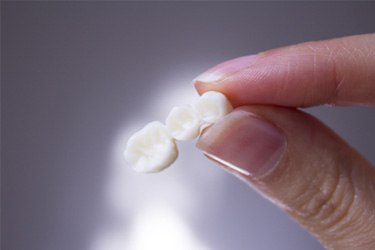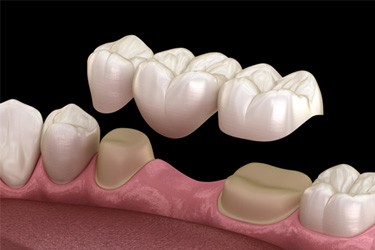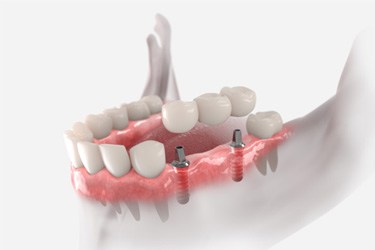Dental Bridges – Schenectady, NY
Fast & Effective Tooth Replacement
 Some patients come to us with just one or two missing teeth, and their remaining teeth are still in good shape. In such cases, we usually do not recommend a denture. Instead, we tend to favor dental bridges. Bridges are an excellent way for patients in Schenectady to regain a complete and confident smile without a long treatment process or extremely high care costs. If you would like to learn more about this fast and effective form of tooth replacement, get in touch with our team today.
Some patients come to us with just one or two missing teeth, and their remaining teeth are still in good shape. In such cases, we usually do not recommend a denture. Instead, we tend to favor dental bridges. Bridges are an excellent way for patients in Schenectady to regain a complete and confident smile without a long treatment process or extremely high care costs. If you would like to learn more about this fast and effective form of tooth replacement, get in touch with our team today.
Why Choose Capital Smiles For Dental Bridges?
- Natural-Looking Restorations
- Sedation Available for Patient Comfort
- Traditional & Implant Bridges Available
What Is a Dental Bridge?

A traditional dental bridge has a crown on each end. Each of the crowns gets placed on one of the teeth next to the empty space, called the abutment teeth. They support 1 – 3 pontics (artificial teeth) between them. Bridges are a common method for addressing minor cases of tooth loss.
Bridges can be made out of various materials. Here at Capital Smiles, we tend to favor zirconia because it bears a strong resemblance to natural tooth enamel and is durable enough to stand up to the rigors of everyday eating and drinking.
Types of Dental Bridges

There are a few different types of dental bridges. The best one for you will depend on the extent of your tooth loss, your budget, the state of your oral health, and other factors. During your consultation with our team, we will learn about your circumstances and talk to you about your treatment options. Depending on what we discover, we may recommend that you receive one of the following:
Traditional Bridge

This type of restoration is typically what people have in mind when they talk about dental bridges. Traditional bridges rely on the abutment teeth for support and can usually be placed after just a couple of dental appointments. With proper care, this form of tooth replacement could last for a decade or longer.
Implant Bridges

Dental implants are prosthetic tooth roots. They can be used instead of abutment teeth to support a bridge, and they are excellent for providing extremely sturdy tooth replacement. Plus, many patients love implant bridges because, unlike a traditional bridge, they usually do not require any of the nearby teeth to be modified.
The Benefits of Getting a Dental Bridge

Here are some benefits you may enjoy when you replace your missing teeth with a dental bridge:
- A bridge can serve as a placeholder and prevent your remaining natural teeth from drifting out of place./li>
- You can expect to have a beautiful, natural-looking smile.
- You will be able to eat without worrying that food may irritate the gums at the site of a missing tooth.
- With proper care, a dental bridge can last for many years.
Would you like to learn more about dental bridges? Schedule your consultation at Capital Smiles today!
Dental Bridges FAQs

Dr. Page and our team are ready to help you replace your missing teeth with a dental bridge. Before your consultation, though, you may want to know more about what you can expect with this form of restorative treatment. To assist you, we have put together the following list of answers to frequently asked questions about dental bridges. If you do not see your specific question addressed, please reach out to us directly.
Can You Take a Dental Bridge Out?
No, you cannot. Dental bridges are designed as a permanent form of tooth replacement; they can only be removed by a dental professional.
Of course, you might have heard of a “removable bridge,” but that is something of a misnomer. Usually, when people talk about removable dental bridges, they are actually mentioning partial dentures, which are designed to be taken out of the mouth with ease.
Is Getting a Dental Bridge Painful?
Dr. Page and our team want your treatment experience to be as comfortable as possible. When we are preparing teeth for a dental bridge or placing dental implants, we use sedation and anesthesia so our patients feel little to nothing.
Some soreness and/or sensitivity are to be expected after almost any dental procedure. We will give you instructions to help you cope with any discomfort. For example, we may urge you to alter your diet, get adequate rest, and take pain relievers as necessary.
How Many Teeth Can a Dental Bridge Replace?
A dental bridge can be used to replace up to four teeth in a row. Generally, though, they are used to replace just one or two. The longer a bridge is, the less stable it becomes. The risk of destabilization is lower with an implant bridge than a traditional bridge. However, a long implant bridge may need more than two implants to ensure that it functions well for many years.
How Do I Clean Under My Dental Bridge?
Cleaning beneath your pontics is important for maintaining your oral health and preventing gum problems. There are a few different methods you can use to clean beneath a bridge:
- Use traditional floss. Place it through a floss threader, and then slide the pointed end beneath the bridge so you can use the floss to gently clean beneath your restoration.
- Use an interdental brush. An interdental brush is a small tool that sort of resembles a Christmas tree. You can slide it beneath your bridge to clean your restoration and your gums.
- Invest in a water flosser. A water flosser is a tool that shoots out a steady stream of water that can dislodge particles and bacteria beneath a bridge. You can adjust its pressure level to suit your needs.
If you need further guidance on how to clean beneath a bridge, you are welcome to ask our team during your next hygiene appointment.
How Long Should a Dental Bridge Last?
You can expect a dental bridge to last 5 – 15 years, depending on factors such as your oral hygiene routine, diet, and other factors. If you visit us as your dentist in Schenectady regularly and stick to good habits on a daily basis, your bridge could last even longer. Our team can provide you with detailed and personalized instructions to help you protect your dental bridge from harm and premature failure.
Is a Partial Denture the Same as a Bridge?
You might wonder if a partial denture and a dental bridge are interchangeable. Although both replace missing teeth, they differ in form and function. A bridge is anchored to adjacent teeth or dental implants, creating a fixed solution that does not move within your mouth. In contrast, a partial denture is a removable device that fits comfortably in your mouth and can be taken out for cleaning. A partial denture may also replace teeth at multiple locations throughout a dental arch, while a bridge can only replace missing teeth that are adjacent to one another.
Our team can help you compare all your tooth replacement options so you settle on the one that best fits your circumstances.
Can Dental Bridges Be Whitened?
Many dental bridges are made from porcelain or ceramic, which do not respond to traditional whitening treatments. Their color is selected before placement and should stay the same for many years.
If your bridge has become discolored, it might need to be polished or even replaced. Also, keep in mind that if you have not yet received your bridge, you might choose to whiten your teeth before your treatment. Then, your bridge can be shade-matched to blend in with your recently brightened smile.
Do Dental Bridges Look Natural?
We want you to have a confident smile, so we often use extraordinarily lifelike materials for dental bridges. We will carefully match the shape, size, and color of your restoration to your surrounding teeth, providing a realistic and attractive result. Onlookers may not even notice that you have a prosthetic!
On the other hand, some dental bridges are made of metals. While these are durable, they lack the aesthetic appeal of options like porcelain and ceramic.
Do Dental Bridges Feel Natural?
When you first receive a dental bridge, you may experience a brief adjustment period where your restoration feels strange in your mouth. However, you will likely adapt within just a few days.
Our team takes precise impressions with the goal of designing bridges that provide a proper fit and smooth bite, minimizing any discomfort. However, if you ever notice that your bridge does not feel quite right or that it seems not to work well with your other teeth, it might need some slight alterations. Talk to us about your concerns, and we will do all we can to assist you.
